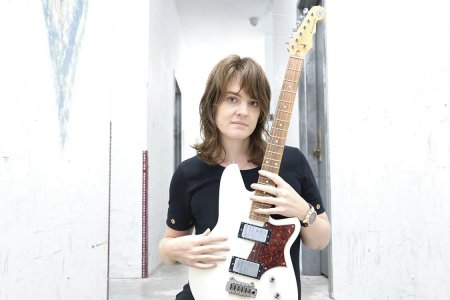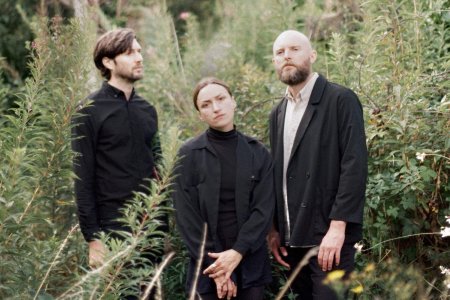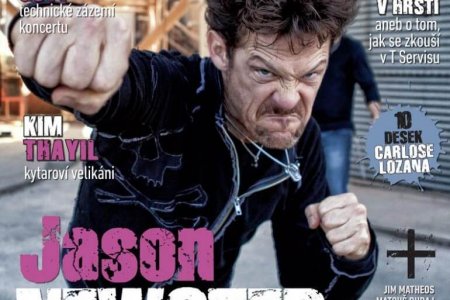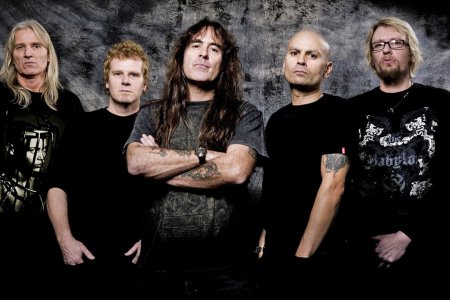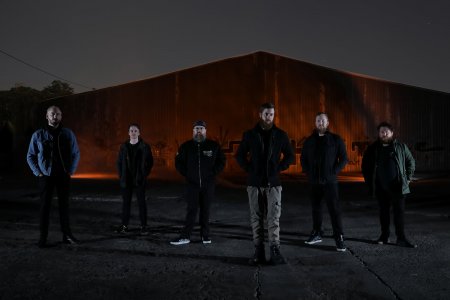When we mention American guitarist Jennifer Batten, she is not only ex-right hand of Michael Jackson and Jeff Beck. We are also talking about highly respected instructional player and innovator within guitar equipment. Since the days she joined King of pop on his three most successful tours and has been songwriting with guitar legends, she had a chance to come across with some of the world’s most unique pieces of gear. Therefore she continuously cooperates with equipment developers from all around the world, to find the best sound and also practical touring weight, during her intensive schedule. Our interview, originally released in Czech magazine Muzikus was conducted in 2016, before her show at multicultural festival in Prague called “Kytara napříč žánry” (Guitar through genres), where she presented not only her current unique show full of performances and video footages, but also arranged guitar clinic for young players.
Gear
Let’s start with your Signature Washburn JB100 – How did this light swamp ash model deserve to be with you since Dangerous/History tours?
The JB 100 was a modification of something Washburn sent to me at a time when I was playing more Stratocaster type guitars. So when I first saw it I was not thrilled. But when I picked it up and started playing it, it just felt very very comfortable. The actual JB 100 is very similar to that initial model that they sent to me but I changed out the pickups to a Seymour Duncan JB Junior in the bridge and two Duckbuckers. I was also playing with Jeff Beck at the time and triggering a lot of synthesizer, so I had them make a model with the Roland GK2 pickup built inside. So there were actually several models available; American-made regular plus the option of the synth pickup as well as very good quality Korean made models (regular and synth). I was so happy with the guitars, I didn’t bother looking at any of the guitar for about 15 years. I insisted on a light guitar, so swamp ash was chosen. They also have glued in necks that make it very comfortable to play up high. I have just now started using a brand-new Washburn Parallax PXM-JB10 guitar which is even better. It’s the only Parallax Strat shape with a short scale neck.
What are some of the differences between this model and Parker Bronze Fly, and mainly Strats, that you used before you fell in love with Washburn?
The Parker Bronze Fly is a completely different animal. I inherited it from my father when he passed away and didn’t touch it for a couple years. But when I finally picked it up, I was blown away by how light it is and how rich the sound is. I really appreciate a light guitar, so I spend a lot of time practicing with it. It also inspired me to write a couple of acoustic songs. It’s such a shame they don’t make them anymore. I am also interested at some point in acquiring the Parker Fly Nylon string which is no longer made.
However you didn’t give up on the Strats completely, as Seymour Duncan JB bridge and Duckbuckers give the Strat “vibe”, as you once said.
As for electric, since it has been so long that I’ve been playing a Gibson scale, Strat’s are a bit of a struggle, so I have gotten rid of all of my Strat’s. The sound of the bridge in middle pickups of a Strat is the ultimate though, so I do what I can to re-create that sound with other guitars and pickups. Stacked pickups and humbuckers are a godsend. I would never have considered to take an unaltered Stratocaster on the road with original pickups. The amount of noise is unbearable and you will invariably run into venues with horrific ground problems around the world and even in America. Washburn gave me two new Parallax guitars and in one they kindly inserted my requested Variax electronics. There are many reasons I wanted that and one of them is that sometimes even humbucker guitars are noisy in certain venues. With Variax electronics you have the option of choosing the virtual pickups which is dead silent.

I gave up on using a guitar midi system because 99% of my gigs involved traveling and I just could not take the extra equipment
What are some of the interesting parts that you’ve added on the guitar, next to an Apple remote?
I have actually gotten away from using the Apple remote which was velcroed to the guitar body, because it’s not 100% reliable in stopping the films during my solo performance film shows. So I have opted to have a laptop on the table next to me that is 100% reliable when I hit the spacebar. I always add one of my Batten String Dampers (http://www.powerpresskits.com/PPKs/indexC.aspx?PPK=758) to all of my guitars. It is a short arm attached to a base that is attached to the headstock. The part that hits the strings is piano string damper material. I started using it for tapping, but now I use it almost all the time unless I know I will need harmonics open strings, because it just makes everything cleaner. I can quickly flip the arm up or down as I choose. Anyone interested can find them for sale on my batten.com website store.
Could you please also explain us the benefits of Fishman TriplePlay compared to Roland’s GK-2?
The Fishman TriplePlay is light-years beyond the Roland GK2 system. With Roland, the 13 pin cable required to go out of the guitar into a sound module is old news. The cables are expensive fragile, and unreliable. Fishman came up with the ultimate design – especially for travelers like me. After I played with Jeff Beck, I gave up on using a guitar midi system because 99% of my gigs involved traveling and I just could not take the extra equipment ie a sound module, 13 pin cable, and midi converter. Now with the Fishman TriplePlay, all you need is a lightweight plastic controller which is attached to a hex pickup mounted on the guitar. The receiver is a USB dongle and I insert it into my MacBook air which I always travel with anyway. The software is easy to use and the sounds are great. You don’t need any cables because it is wireless. I run a cable out of my laptop headphone output into a volume pedal so I can adjust the volume if I need to, and then it goes into the house sound (DI) and back into my monitor. They are also releasing the FC1 pedal which allows anyone with external sounds or keyboard modules to access all those sounds by putting the USB receiver into the pedal instead of into a laptop. With the FC one pedal, you can change patches with your foot instead of from the guitar controller. It also allows you to insert an expression pedal and there is also a hold button on the foot controller.

I’ve dreamed of having an amp that weighs next to nothing that gets saturation from a tube for decades!
Is it also a reason, why you prefer light and equally loud in all directions – BluGuitar Amp1, BluGuitar Nanocab? Would you recommend it to practically anymore, based on the balance between performance and price?
I’ve dreamed of having an amp that weighs next to nothing that gets saturation from a tube for decades! Every time I pack for a flight, I spend time thinking of how I could possibly make things lighter. Airlines are always allowing less and less weight, especially in Europe. It’s near impossible to take what you need. I just happened to be a Thomas Blug’s home on a day off just to say hi. I had no idea he was even an amp designer. I just knew him as a great guitar player. When I played through the amp, I was so excited I asked how soon I could get one. It’s truly a genius design. It’s a revolution in guitar amplification. It will take some education for people to understand that it’s a full out 100 watt 4 channel tube amp that weighs only 2 pounds. Even after I explain it to people, they think it’s just a pedal or a pre-amp, but it’s the full amp. You only need to send a speaker cable from it to a speaker. Done! I put it in a backpack or gig bag for transport.

Thomas Blug’s amp is a revolution in guitar amplification
You are and always were a big fan of solos. Could you please mention some of the useful tools for tapping and solos? – Type of strings, extra tools…
As for tapping, I think it’s valuable to have some sort of string damper to give you the freedom to just play and not worry about muting. My Batten string damper I think, is a bit less fussy that the hair ties some people use. I think lighter strings and low action help, but it’s really up to the player and what their used to. If they have heavier strings and have no problem tapping, then they should stick with it. People’s set ups are so individual that aside from tapping, I couldn’t recommend anything.
Next to solos, you are also a big fan of effects. Does Digitech RP1000, provide you all the options you need or you have to add some additional effect tools?
The RP1000 is all I need. The whole idea of individual pedals seems like such a fussy mess to me. I want to just kick in one preset and have everything sorted out i.e. in one preset I might have a talker sound with delay set in time for a certain tune and also choose the Blug Amp 1 in the routing instead of the internal modeling. I don’t want to have to kick in 2 or 3 buttons for a sound when I want it to change instantly. It takes away from the performance. However, there is one pedal I have my eye on that is an advanced ring modulator: https://www.youtube.com/watch?v=_B0bcXuKjW4
But in the end, I like it simple when I travel. Adding a pedal in the RP pedal loops is just one more thing to have to deal with. I’d rather use the Fishman TriplePlay and a laptop for an infinite alternative variety of sounds.
Would you like finalize, this gear part by mentioning some other unique part of your equipment that we haven’t mention so far, or you rarely have an option to mention?
I always use volume pedals. For one thing, you get silence between songs and you can pump or decrease volume as needed. If you have a volume set and the drums get too noisy, you get buried. If you turn up and then go into a quiet part you’re too loud.

I’d rather use the Fishman TriplePlay and a laptop for an infinite alternative variety of sounds
I would now like to cover your solo career releases. What first two albums have in common are Pamelina’s graphics. I can see you support her till these days, but what do you love on her style the most?
It’s that she puts her personality into her work and has great attention to detail. The work she put into my first album cover was astounding and I marvel at her talent.
Above, Below & Beyond
Truly wild, fun, full of effect experiments and joyful album – Where did this come from?
It was my debut CD, so I put everything into it I could think of as well as performing a variety of styles. I like to listen to music that has a lot of variety, so that’s what I play for people. That came out at the peak of the guitar revolution in the 80’s. It seemed everyone was into gymnastic guitar at that time, and a lot of boundaries were being pushed. I did what I could to push myself and put my stamp on an identity.
I recently saw Joe Satriani live in Czech Republic and I spent with his music due to an interview and reviews quite some time. Your joyful playing on this album reminded me a bit of him. It’s all you, but were you also influenced by him as well?
I was teaching at Musicians Institute at the time he came out, so students were interested in his stuff. So I learned a few things to show to students, but I cut my teeth on guitar earlier than that with Jeff Beck mostly. That’s the most time I put into actually learning someone else’s solos. I learned tons of other solos, as well including Charlie Parker, Joe Pass and Van Halen. So it was quite a huge variety of material and genres I was stuffing into my grey matter in my late teens and early twenties.
When did you decide, you want to make a solo recording?
I announced in 79 to the president of Musicians Institute that I’d have a record done in a year. It was actually ten years.
Was it also a question of timing? You’ve probably gathered due to cooperation with Michael Jackson needed input of attention and respect – Basically, „Now I can do it…“
I started demos with Michael Sembello (Maniac from Flashdance movie) prior to the first Jackson tour and finished the record upon return.
Next to the composing and singing, you also produced the album. Where did you gather skills to do that and how did you separate roles with Michael Sembello that you knew for quite a while? In what way did he kick your butt, in some aspects?
Luckily he taught me the auto punch feature on one of the first big time digital machines. So he’d leave me alone to record for many hours at a time. I think he was really just being kind in the credits for me being a co-producer. I really mainly looked after guitar production, but wrote and arranged the tunes as well. He took my crap demos and realized them into a higher quality thing.

I announced in 79 to the president of Musicians Institute that I’d have a record done in a year. It was actually ten years.
What type of promo have you chosen with a label back then? Were you satisfied with the balance in the promotion of your work and pushy marketing terms of the label: „Michael Jackson’s guitarist.“?
I was bummed about the whole business side of it. I had a record label that I didn’t realize until it was too late, didn’t have distribution in Europe. So when I was promoting the record by hiring a publicist myself during the Jackson’s Dangerous tour, there was no product in the shops and it was way before the internet, so people couldn’t just download a record after reading about it.
Jennifer Batten’s Tribal Rage: Momentum
Same as on the first album, there is insanely big number of guests. Could you give us an idea, how did you separate the roles?
For the first record, a lot of those guests were made up as a joke, like the orchestra. That was programmed. Other guests were Sembello’s friends. He worked with Stevie Wonder so got Stevie’s background singers in for Respect. I got Greg Philingaines from Jackson’s band to play on Giant Steps, and a good singer for Respect, because I don’t sing. For Momentum, 95% was Glen Sobel-drums (now with Alice Cooper), Ricky Wolking (bass) and myself. I did all the synth work as well as guitar. I brought some friends in for some minor vocal chanting, but that’s about it.
On the other hand, most of the guests changed since the first album. I salute to your radius of contacts and sources for talents…
My second record was self-produced, so any guests were friends. There was a big growth spurt between records and several years between as well. I was able to do my vision 100% and any arguments that I lost the first time around in having a producer, became a friendly compromise with Glen and Ricky. That record was a sheer joy and we’re all still friends.

I was able to do my vision 100% and any arguments that I lost the first time around in having a producer, became a friendly compromise with Glen and Ricky
Compared to the first album, this piece shows more concentrated playing. There are fewer, yet longer songs and the songs are calmer and kind of grown-up/adult/slower – why?
The second record was a true group project and much more organic. No drum programming. In hindsight I should have done a lot of editing time wise, but we just let it flow naturally. I couldn’t explain why it came out like it did other than it just did. We all let our creativity flow.
How are you satisfied with a 2008’s reissues for both first and second album? Was it related to the deal with Lion music?
I actually never listened to the reissues. I’d heard the material enough by then. Lion was cool. I’m not the most organized person, so it was really difficult to come up with the original art work etc, so perhaps the graphics weren’t as crisp as they could have been but it wasn’t their fault.
Whatever
Why did you return to the wild and funny sound? Well, even wilder than on a debut…
I think music should reflect your personality. I like to have fun. For me it’s just part of the creative process to put some humor in the music. Most of Whatever was written originally for Jeff Beck when I was touring with him. In fact my song In the Aftermath was written for him and it morphed into a tune called Loose Cannon on his You Had It Coming CD. I got turned on to ProTools recording for the first time when I worked with him, so I got myself a computer system and used a lot of the tools and sounds that were not previously available including the latest Digitech had to offer at the time. I use the crap out of their Whammy pedal.
There is some of the best guitar playing since, but Hip hop – ok. Farts & burps? What the hell? ;D
My mother wouldn’t have been pleased, but in part it seemed like a great marketing tool to get younger boys engaged. In the end, all sound is music and it was just a fun tune to put together with sampling rude noisesJ. That opening arm fart tuned out so stellar it became the hook.
When did you become interested in world music? (Travels with Michael and contacts with unique musicians all over the world?) I’m fully aware of your love for Africa – Do you travel there once in a while and listen to the music?
I’ve only ever been to S Africa once and it was with Michael. But prior to that I think originally my interest came from watching Tarzan movies and listening to the African drumming. It was so exotic and stuck with me. From there, my next memory was the ethnic sounds from Weather Report, which remains my favorite band ever. I got bored with top 40 rock n roll and was looking for something fresh in part.
This music has plenty of tribal characteristic and I guess it also showed in your music in a way that in certain parts you take a guitar as a percussive instrument? Do you what I mean?
When I got into tapping, I realized I had a whole new instrument available to me. It gave me the freedom that a pianist has to create a rhythm between the two hands. The song Cruzin the Nile was my first big experiment in seeing what I could do percussively on the guitar.
Are you a fan of African-American humor and stand-up? It came across my mind, when I heard “Ass whooping” in your music. I personally love stand-ups of Chris Rock, Eddie Griffin, Jamie Foxx, Chris Tucker…
Sure, there is some stellar talent there. Kevin Hart is the newest to crack me up. He’s genius. He was recently hosting a roast of Justin Bieber that was fantastic. Having said that, I’m really just a fan of humor regardless of race. If it’s fresh and unexpected and makes me laugh, I’m a fan. It’s not just the jokes but the delivery is everything.
Current activities
What do you do now to grow and constantly evolve as an artist and guitar player?
I realize there has to be a balance of input and output, so if I go through phases of not feeling creative I’ll either start working on a nonmusical art project to recharge, or just go into input mode for a spell. That can be going to shows, movies, reading or anything else that might light my fuse. As for music, it’s usually anticipating tours and audience reaction that fires me up to do new things.
How was your trip to India?
I’m glad I went but wouldn’t want to go to that region again. It was in Nagaland which is a very remote area in the east where the roads are total shit. My hosts gave me the best of the best, but after having gotten a ridiculous amount of preventative medicines and realizing there’s still no cure for Dengue fever of which I saw multiple warnings, I’d rather stay more in the western world.
Next to instructional footage DVD’s, you also arrange numerous clinics. Is it rewarding to see the progress of your students and what is the main part of the curriculum?
I do love to see the light bulb go on with students when they finally get something and the fret board opens up to make more sense to them. I’ve been doing product clinics for many years for guitar or effects companies. That is really more of a concert where I speak about gear between songs instead of speaking about the song itself. For ten years I’ve added film as well whether it’s for a concert or a clinic. Last summer I launched a whole other kind of seminar though called “Self Empowerment” for the Modern Musician. Although I started with having some playing in them, it was a 4 hour seminar with multi subjects and it was obvious the first week that there just was no time to play, because I couldn’t even get through the subjects. The seminar included loads of lessons I’ve learned along the way about being a pro musician including travel, eating life giving foods, controlling brain input like deleting energy sucking news. It was the best ways to learn new music and information about modern advancements in neuroscience and programming your brain to a higher manifestation of the life you want. I traveled with my partner Jesse Solomon for two months across America. It was just phase one and I’ve got a lot more to add to the course and will eventually make it downloadable.

I do love to see the light bulb go on with students when they finally get something and the fret board opens up to make more sense to them
Could you please give us an idea how your show looks like? Is it a combination of a clinic, multimedia show and a show with other musicians?
I do a wide variety of performances. It just depends on what is asked of me. For my solo shows, it’s just me playing guitar and telling stories. Every tune is in synch with films I’ve made. I also play with bands and have played with a multitude of Michael Jackson tributes. I’ve been going to Poland for 4 years annually now and play instrumentals with a band there but usually open the show with 30 min of my solo show for variety.
Could you give us an idea of your filmmaking activities?
I got the idea for the film show years ago and love making films. I just put together 3 or 4 new ones just for the NAMM show to demo sounds for the TriplePlay, so when I do Stevie Wonder’s Isn’t She Lovely triggered harmonica solo, you’ll see photos of him in the background playing harmonica. I also put together a Weather Report medley and will be triggering a fretless bass sound, so there are loads of Jaco photos in the film. For my show, it’s a huge variety of imagery and even some animation depending on the subject of the song. I also did a film for Britney Spears’ Oops I Did It Again as a joke. I like the melody so it works well for an instrumental song but the film is the funniest project yet. It’s full of performers falling on and off stages during the choruses.
How are you looking forward for the tour with Uli Jon Roth? Did he belong into you list of heroes and how the show will be organized? Solo shows or full time G3 style?
I played a few festival shows with him a couple years ago. He liked the film idea so he thought it would be a benefit to have it in the middle of the 3 guitar player’s tour instead of having 3 bands. It really breaks up the evening nicely with variety and also gives the audience an ear break between Andy Timmons playing with the band and Uli. It also gives the band a break because they have a load of playing to do. I’ll also join the band for a couple tunes.
In October you are coming to Prague on an event called: “Kytara napříč žánry” – multicultural world of guitar players. What can guests expect from your show?
Right now I expect I’ll be doing my solo show. People can get an idea from a sample film at the bottom of my “performances” page on my website. By the time I get there, there may be a clinic or two booked as well. I don’t know yet.
The name of the event – “Guitar through genres”, tends to describe you pretty well. You have cooperated with various nationalities (Shuichi Hidano), but also genres (very surprising cooperation with Dave Rogers). What motivates you to seek such diversity?
A lot of that is diversity seeking me, and me gladly excepting. Since the internet is now in most people’s homes, anyone can seek out a player for projects or tours. I might wake up on any given day and get offers for sessions I can record at home for somewhere else on the planet, or get a request to fly just about anywhere and play in a variety of situations. In a couple months I’ll be playing on a Pink Floyd Tribute in Italy. That will be a first for me. The more I travel, the more I’m on people’s minds.
If we take just guitarists, you have cooperated with number of guitarists – female/male, legends/less known talents… Next to the fact that you must be very good person to hang around and to cooperate with – What do you seek in all those cooperations? I also tend to assume, each time two different guitarists meet, the contact must be unique. Sometimes it works perfectly, sometimes not, but you can still be professional and find a solution how to support each other…
Some collaborations work better than others. If there is a mutual respect it can be really fun and new friends are made. But sometimes people are fear and ego based and they won’t let you into their hearts. In that case, it’s difficult for flow to happen and you leave the situation usually never thinking about them again. You just keep moving on to like minds. I’m usually open to any new situation unless I really believe it’s over my head.

I’m usually open to any new situation unless I really believe it’s over my head.
Jeff Beck
How did you enjoy playing with one of your all time heroes? Your duets/co-playing sounded really unique…
It was an unexpected honor to be asked to join Jeff for the 3 years of touring and recording. He was always really cool to me, respectful and appreciative of my efforts. Because he was a lifetime hero, it was sometimes intimidating to play with him. But I worked as hard as possible and he was really lightweight and cool and not overly demanding, so he made me feel as comfortable as possible. I learned a hell of a lot and had way more responsibility than ever in the past. I was the harmony whether it was triggering synth sounds or playing guitar. There were only 4 of us on stage. In the Jackson band there were two keyboards and 2 guitars, so if I made a mistake, it was no big deal. It was a true joy playing with Jeff. I had once learned all of his solos on the Blow by Blow and Wired CD’s so his playing is really internalized. It looks like we’ll unite once again for a special concert this summer. No details yet.
As mainly a rhythm guitarist, did you have enough space to be creative and give space to your wild ideas?
I was happy with my role. I would have been content to only play rhythm and synth but he had me solo and trade solos as well. It was a dream gig for me, so I was happy with anything. It’s important to understand your role when you’re touring with a big name. It’s about them, not you. It’s about supporting them the best you can so they can soar.

It’s important to understand your role when you’re touring with a big name. It’s about them, not you.
Michael Jackson
Why you did not participate on the recordings? Was this role already well established by other people? I spoke to TOTO members few times, so I assume, they wanted to keep their territory and other hundreds of people. Steve Stevens at least has one solo on Bad album…
He got guys with hit records to do solos on his records which is smart for marketing because you get a cross over audience. As for studio sessions, they were always done when I was called for touring. Michael had a posse of people he’d used for years for recording. Jonathan Moffet for instance had recorded with him since the Jackson 5.
I assume, it was not hard for you to learn the songs, but did you add live sth from you to the songs?
I learned the songs note for note and we all spent time trying to copy the tones as well, especially in the keyboard department. Then as we started staging, there was space for instance in Working Day and Night that allowed for improvising. That was always an open amount of time every night and Michael would visually wind it up when he thought I played long enough.
I also must compliment to your hairstyles over the years, especially nowadays. But back then, it was a BIG hair. Look of Grace Jones, hair that even Nitro band could be jealous. Young generation can hardly imagine, but how much time did you have to spend preparing it?
Michael hired pros to draw up various looks for me and then hire people to make it a reality. He wanted me to stand out so the hair was all his idea. It took 2 ½ hours to get that look ready for a show. I couldn’t do that on my own.

Michael would visually wind it up when he thought I played long enough
When we are remembering those days, next to the big hair, you also had a big guitar sound. You did have access to all the toys in the world back then. What was your secret – that could be heard mainly on 1988 tour and during a Super bowl show? God, what a great job on my most favorite Dirty Diana, Jennifer! I assume it as one of the songs, where you could have most fun as a guitarist…
I had different gear for every tour since they were years apart. I’m pretty sure I used Boogie Mark III’s for that. I didn’t use very many effects back then, probably just delay.
In addition, over the years you must have tried some crazy guitars and designs. Could you remember some of the craziest ones? We could see one in The Flight of the Bumblebee, which looks rather like the one, Tony Levin could use.
The dbl neck guitar I used in that was borrowed from a friend. I couldn’t even play it for real. It was just a cool look for the video.J It’s designed by an Australian named Stuart Box and is called the Box guitar. For playing Come Together in the Moonwalker film, Michael wanted a special looking guitar so someone from Guitar Center brought a bunch of guitar in to choose from. I ended up using a Jackson…When I first joined Jackson I signed on with Ibanez and had several different models over a seven year period. Then I switched to Washburn and have found the necks to be more reliable. I tend to stick to fairly mainstream body types these days.

